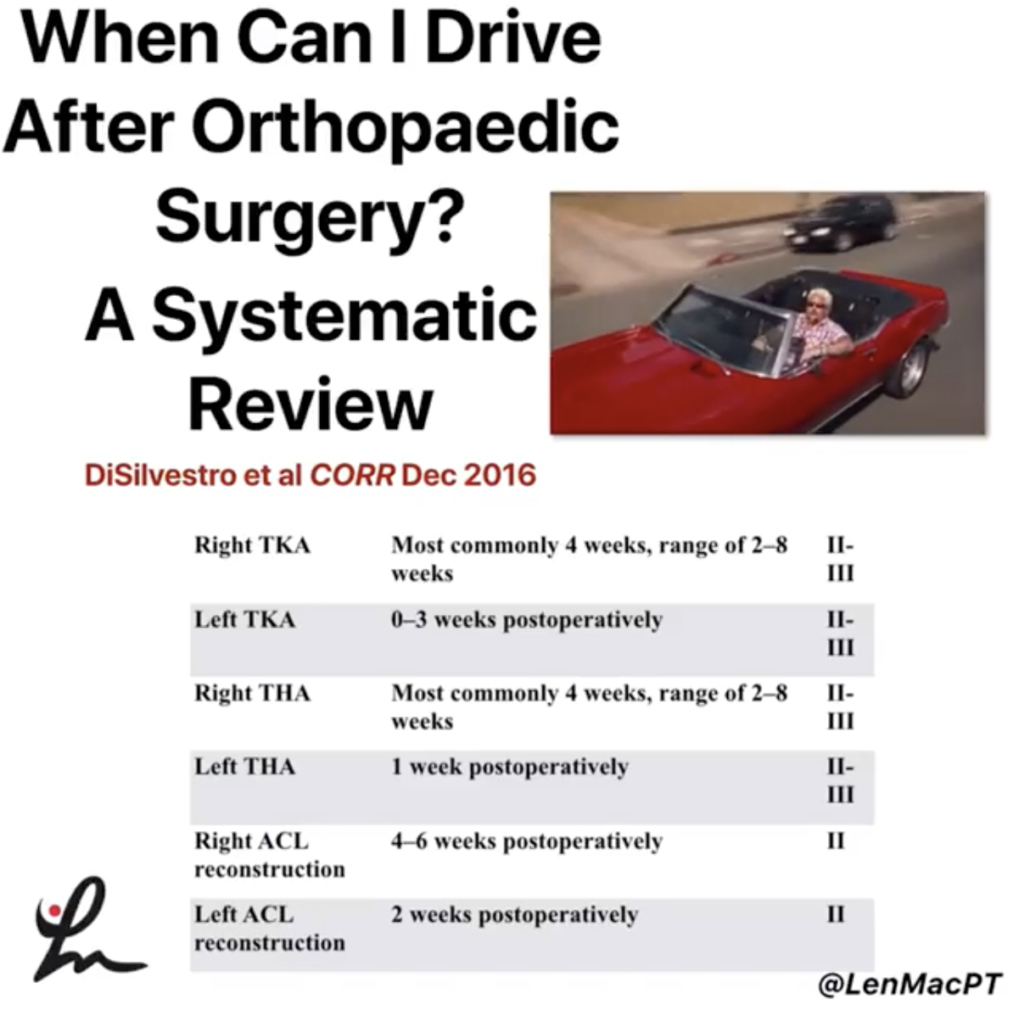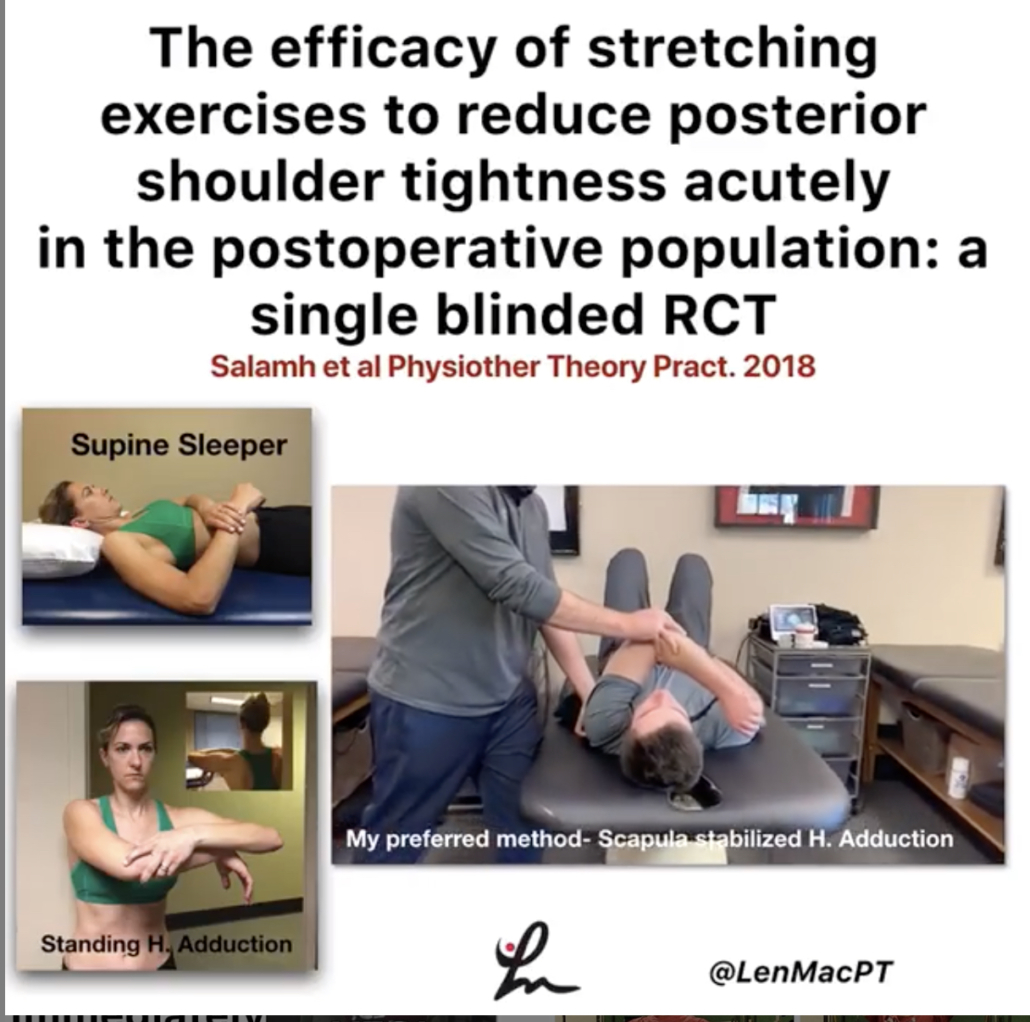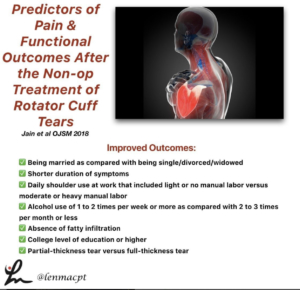
Predictors of Pain and Functional Outcomes After the Nonoperative Treatment of Rotator Cuff Tears Jain et al OJSM 2018
Who should have RTC surgery and who may not need RTC surgery? That’s a big question but this study tries to give us a better understanding.
70 patients with rotator cuff tears were diagnosed based on the clinical impression of a sports/shoulder fellowship–trained attending physician and evidence of structural deficits on MRI (when available). In cases where an MRI scan was available, both of these conditions had to be met for a patient to be diagnosed with a rotator cuff tear. If an MRI scan was unavailable (because it was not clinically indicated; n = 14), the diagnosis was based on the clinician’s impression.
The Shoulder Pain and Disability Index (SPADI) was used to determine the level of disability at 3, 6, 12, and 18 months.
✅Being married as compared with being single/divorced/widowed
✅Shorter duration of symptoms
✅Daily shoulder use at work that included light or no manual labor versus moderate or heavy manual labor
✅alcohol use of 1 to 2 times per week or more as compared with 2 to 3 times per month or less
✅Absence of fatty infiltration
✅ College level of education or higher
✅ Partial-thickness tear versus full-thickness tear
Interesting results, especially the alcohol use and being married (kinda surprising but intriguing). Does this help you to guide your future patients if they ask about RTC repair surgery? Tag a friend or colleague who may benefit from this information…thanks!
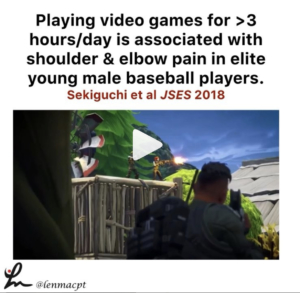
Playing video games for more than 3 hours a day is associated with shoulder and elbow pain in elite young male baseball players. Sekiguchi et al JSES 2018
[HOT OFF THE PRESS] in Sept 2018 issue showing the potential effects of playing video games on injury rates in youth baseball players.
200 Japanese ‘elite level’ male baseball players ages 9-12 years old were included in the analysis.
Playing video games for ≥3 hours/day was significantly associated with an elbow or shoulder pain vs. spending <1 hour/day playing video games.
The amount of time spent watching television was not significantly associated with the prevalence of elbow or shoulder pain.
Originally saw this study on Twitter by Dan Lorenz and thought it was interesting, considering @redsox pitcher @davidprice14had a recent injury and attributed it to playing video games.
Not sure how valid the results are but I just wanted to share with my friends and get your opinions. Tag a friend or colleague that may be interested in these results…thanks!⠀

Shoulder Stabilization Drills
More closed chain rhythmic stabilization drills that we like to utilize at @championptp for our upper extremity patients.
A recent study in 2014 Kang et al showed “The EMG activity of the infraspinatus and the ratio of the infraspinatus to the posterior deltoid activities were significantly increased, whereas the posterior deltoid activity was significantly decreased under the CKC condition compared to the OKC condition.”
I prefer to position the patient with an open palm to make it a less stable surface on the ball. Cue them by telling them ‘don’t let me move you’ as I give manual perturbations along the forearm.
To advanced the drill, we can have them perform it with their eyes closed or in a single-legged stance position with their push-off leg on the ground (if they are a pitcher).
You can also advance them in a time-based manner by extending the duration of the exercise to focus on more of the endurance aspect of the rotator cuff.
This is a great drill for those patients with hyperlaxity that need a relatively stable position to perform their exercises in a relatively pain-free fashion.
Do you utilize these drills or know someone that may benefit from them? tag them below so we can discuss them further…thanks!
Credit to @shift_movementscience for the ER wall stabilization drill that he showed us recently. We always performed them IR Wall Stab drill but a quick 180-degree shift and we got a great posterior RTC exercise!⠀
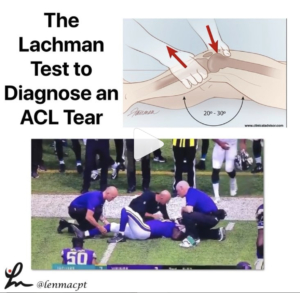
Lachmans Test for an ACL Tear
Video showing an obviously positive Lachman’s test in a recent @NFLpreseason game.
Check out the anterior translation of the tibia on the femur while the knee is flexed to about 25 degrees.
This is the best way to diagnose an ACL injury and should be the 1st ACL test that you do in your clinical exam.
Remember to rule out the PCL or you may get a false positive if you see excessive anterior translation because the tibia is sitting too far posteriorly.
According to Benjaminse et al 2006, The Lachman test is the most valid test to determine ACL tears, showing a pooled sensitivity of 85% and a specificity of 94%. There are numerous other studies that conclude this as well.
They even discuss the pivot shift as a test to consider but I think the Lachman’s test will be the most valid overall.
Do you agree? What do you think? Tag a friend or colleague who may benefit from this post…thanks!

Shoulder Drills
[REPOST] from @tony.comellatalking bodyweight drills that you can use as a warm up or even as part of a shoulder rehab program. Take a look below and applaud these movements by Tony! 👏🏼⠀
⠀
BODYWEIGHT SHOULDER DRILLS⠀
—⠀
🙋🏻♂️The shoulder can get overly complex, but the goal of this post is to keep it simple. There are a ton of exercises we can perform, utilizing a variety of equipment (bands, weights, barbells, cable, etc), but here are a few drills I like to perform using only bodyweight:
1️⃣ Prone swimmers. This drill can be deceivingly challenging, as we fight against gravity to keep our arms above the ground. Try and keep your arms as high above the ground as you can and elbows straight (think about reaching fingertips away from you). If you have trouble on the ground you can do this on a bench, or if this is too easy, hold some light weights <5lbs. No need to go too heavy here, as your ability to move a lot of weight won’t impress anybody.
2️⃣ Downdog toe tap. We get the shoulder into full flexion overhead (working on serratus) and some thoracic spine movement too. AdAn additionalonus is showing some love to the posterior chain (hamstrings, calves).
3️⃣ Bear roll. You can’t work on overall shoulder health and not include thoracic spine drills. This beautiful dance move targets the thoracic spine and closed chain shoulder stability at the same time.
😎These are 3 great bodyweight exercises to mix into your warm-up or exercise routine for overall shoulder health. Which one is your favorite?
